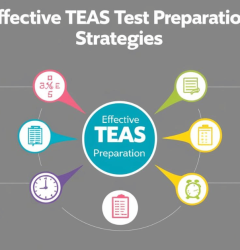- Email: hello@Tutoriffic.com
- Phone: (714) 941 0782

The TEAS test plays a crucial role in determining admission to nursing and allied health programs. It assesses essential skills across multiple subjects, making it a challenging exam for many test-takers. While some may find certain sections easier, others struggle with specific parts due to time constraints, complex questions, and the depth of knowledge required.
In this article, we will explore the most difficult sections of the TEAS test, why they are challenging, and the best strategies to tackle them effectively.
Why Do Some Sections of the TEAS Test Feel Harder Than Others?
Every test-taker has different strengths and weaknesses, but certain sections of the TEAS exam tend to be more challenging for a majority of students. The difficulty of a section depends on factors such as:
- Volume of Content: Some sections cover a broader range of topics, requiring more extensive study.
- Time Pressure: Sections with lengthy questions or calculations can be harder to complete within the given time.
- Application of Knowledge: Some questions require not just memorization but the ability to apply concepts to real-world scenarios.
- Question Complexity: Certain sections, like Science and Math, contain multi-step problems that demand deeper understanding and problem-solving skills.
Based on feedback from test-takers and difficulty levels, Science and Mathematics are widely regarded as the most challenging parts of the TEAS test. Below, we break down why these sections are tough and how you can prepare effectively.
1. Science Section – The Most Difficult for Many Students
Why is the Science Section Hard?
The Science section of the TEAS exam is often considered the toughest because it requires knowledge from multiple disciplines. Instead of just recalling facts, test-takers must apply scientific concepts, analyze information, and interpret data in some questions.
Key Topics Covered in the Science Section:
- Anatomy and Physiology – The largest portion of the Science section covers human body systems, organ functions, and biological processes.
- Biology – Cell structure, genetics, DNA/RNA, and macromolecules.
- Chemistry – Chemical reactions, the periodic table, and molecular interactions.
- Scientific Reasoning – Interpreting data, making observations, and drawing conclusions from experiments.
Challenges Students Face in the Science Section:
- Heavy Memorization Required – A deep understanding of multiple biological and chemical processes is necessary.
- Application-Based Questions – You must not only know definitions but also apply concepts to real-world scenarios.
- Interdisciplinary Topics – Some questions combine biology, chemistry, and human physiology, requiring an integrated understanding.
How to Overcome the Science Section Difficulties:
- Prioritize Anatomy & Physiology – Since this is the biggest part of the section, mastering it will significantly impact your score.
- Use Flashcards for Memorization – Helps with quick recall of biological and chemical terms.
- Take Timed Science Practice Tests – Get familiar with question types and improve speed.
- Watch Educational Videos – Video explanations can simplify complex topics if you struggle with chemistry or biology.
2. Mathematics Section – Time-Consuming and Tricky
Why is the Math Section Hard?
The Mathematics section is challenging due to the variety of problem types and the need to solve calculations quickly. Some students struggle with basic math concepts, while others find it difficult to interpret word problems correctly.
Key Topics Covered in the Math Section:
- Basic Arithmetic – Fractions, decimals, percentages, and ratios.
- Algebra & Word Problems – Solving equations, understanding variables, and translating word problems into mathematical expressions.
- Measurement & Data Interpretation – Metric and standard unit conversions, graph interpretation, and statistics.
Challenges Students Face in the Math Section:
- Word Problems Can Be Confusing – Many questions present real-life scenarios that require careful reading and problem-solving.
- Time Management is Crucial – Since solving equations and interpreting data takes time, students often struggle to finish the section on time.
- Formula-Based Questions – Some problems require memorization and correct application of formulas.
How to Overcome the Math Section Difficulties:
- Master Basic Arithmetic – Ensure proficiency in fractions, percentages, and decimals.
- Practice Word Problems Daily – Strengthens problem-solving speed and accuracy. Memorize Essential Math Formulas – Learn area, volume, percentages, and ratios formulas.
- Use a Timer While Practicing – Improves time management and efficiency.
3. Reading Section – Tricky Passages and Inference-Based Questions
Why is the Reading Section Hard?
The Reading section tests comprehension, analysis, and inference skills. While it may seem easier than Science and Math, many test-takers struggle with understanding complex passages and answering inference-based questions.
Key Topics Covered in the Reading Section:
Main Idea and Supporting Details – Identifying a passage’s main point and key facts.
Understanding Author’s Purpose – Determining why a passage was written and the author’s intent.
Inference & Interpretation – Drawing conclusions that are not directly stated in the text.
Challenges Students Face in the Reading Section:
- Passages Can Be Long and Complex – Requires quick reading and comprehension.
- Inference-Based Questions – Some answers are not explicitly stated and require critical thinking.
- Tricky Answer Choices – Some options are misleading and require careful analysis.
How to Overcome the Reading Section Difficulties:
- Practice Skimming & Scanning Techniques – Helps locate key information faster.
- Improve Comprehension with Active Reading – Take notes while reading and summarize paragraphs.
- Take Timed Practice Tests – Builds familiarity with different question types and improves reading speed.
4. English & Language Usage Section – Grammar and Sentence Structure Challenges
Why is the English Section Hard?
The English and Language Usage section assesses grammar, sentence structure, and vocabulary. It is often challenging for students who are not confident in their grammar skills.
Key Topics Covered in the English Section:
- Grammar & Sentence Structure – Subject-verb agreement, sentence fragments, and punctuation.
- Word Choice & Spelling – Choosing the correct word in context.
- Contextual Vocabulary Usage – Understanding the meaning of words based on sentence structure.
Challenges Students Face in the English Section:
- Grammar Rules Can Be Tricky – Many students struggle with subject-verb agreement and sentence correction.
- Similar Answer Choices – Requires attention to detail to choose the correct option.
- Limited Time to Answer – Quick thinking is essential in only 37 questions in 37 minutes.
How to Overcome the English Section Difficulties:
- Review Grammar Rules – Focus on subject-verb agreement, punctuation, and sentence structure.
- Expand Your Vocabulary – Learn frequently used academic and medical terms.
- Practice Sentence Correction – Helps in identifying and correcting grammar mistakes.
Overview of the Hardest Parts of the TEAS Test
| TEAS Section | Difficulty Level | Main Challenges | Best Strategy to Improve |
|---|---|---|---|
| Science | ⭐⭐⭐⭐⭐ (Very Hard) | Extensive content, heavy memorization, and application-based questions | Focus on Anatomy & Physiology, use flashcards, take timed practice tests |
| Mathematics | ⭐⭐⭐⭐ (Hard) | Time-consuming calculations, complex word problems, and formula-based questions | Practice word problems daily, memorize key formulas, and use a timer |
| Reading | ⭐⭐⭐ (Moderate) | Long passages, inference-based questions, and tricky answer choices | Use skimming & scanning techniques, practice active reading |
| English & Language Usage | ⭐⭐ (Easier) | Grammar rules, sentence structure, and similar answer choices | Review grammar rules, expand vocabulary, practice sentence correction |
Final Thoughts
While the Science and Mathematics sections are typically the hardest parts of the TEAS test, each section has its own challenges. The key to success is consistent preparation, targeted practice, and effective time management.
If you need extra support, you may want to consider professional assistance to help you improve your score. Many students opt for:
- Paying someone to take my TEAS test
- Paying someone to take my TEAS exam
- Getting expert guidance for TEAS preparation
Tutoriffic provides reliable and confidential TEAS test assistance to help you achieve your desired score. With the right study strategies and expert guidance, you can overcome the toughest sections of the TEAS test and increase your chances of success.
FAQs About the Hardest Part of the TEAS Test
1. What is the hardest section of the TEAS test?
The Science and Mathematics sections are generally considered the most difficult. The Science section requires extensive knowledge of anatomy, physiology, biology, and chemistry, while the Math section involves time-consuming word problems and calculations.
2. How can I prepare for the Science section of the TEAS test?
To excel in the Science section, focus on Anatomy & Physiology, as it makes up the largest portion of the test. Use flashcards to memorize terms, take practice tests to identify weak areas, and watch educational videos to better understand complex concepts.
3. Why is the Math section challenging on the TEAS test?
The Math section is challenging because it involves fractions, percentages, algebra, and word problems, all under a strict time limit. Many students struggle with converting word problems into equations and solving them efficiently.
4. What is the best way to improve my TEAS test score?
The best way to improve your TEAS score is through consistent practice, time management, and high-quality study materials. Taking timed practice tests, focusing on weak areas, and using study guides can help boost your confidence and performance.
5. Can I get professional help for my TEAS exam?
If you’re struggling with preparation or short on time, you can seek expert assistance. Many students opt to pay someone to take my TEAS test or pay someone to take my TEAS exam through Tutoriffic for reliable and confidential support in achieving a high score.


